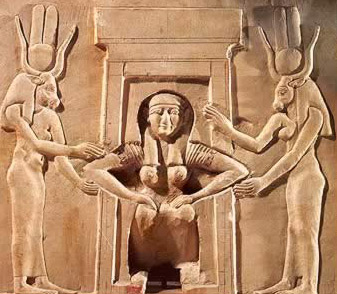Temple Image of Birth from Ancient Egypt

Ancient relief from the Temple of Hathor at Dendera, Egypt
According to independent scholar, Marie Parsons, this temple relief at the Ancient Egyptian Dendera Complex depicts a woman giving birth while squatting and attended by the two goddess figures of Hathor and Taweret. Hathor was a popular deity in Ancient Egypt with many associations, including those of motherhood, fertility, and feminine love. Ancient Egyptians believed that the goddess presided over all births as a guardian of women and children [1]. Taweret was also a key goddess of fertility and childbirth.
Parsons describes the conditions in which labor and delivery took place:
Delivery took place in special surroundings, on the cool roof of the house, or in an arbor or confinement pavilion, a structure of papyrus-stalk columns decorated with vines. A mattress, headrest, mat and cushion and a stool were arranged in the area. At delivery, only female helpers were present, not physicians. The peasant women called two women either from their households or neighbors, and wealthier classes would have servants and nurses present. There are no known words in ancient Egyptian for midwife, obstetrician, or gynecologist.
Women delivered their babies kneeling, or sitting on their heels, or on a delivery seat. This was indicated even shown in the birth hieroglyphic. Often, hot water was placed under the seat, so that the vapors would ease delivery. Delivery sayings were repeated, such as one that asked Amun to “make the heart of the deliverer strong, and keep alive the one that is coming.” [2]
Use of the squatting position and/or of a birth seat appear to have been common in the traditions of Ancient Egypt. Contemporary birth traditions also advocate the use of squatting and birth seats as aids in birth, both of which encourage the utilization of gravity as a natural aid in the process. For several other Visualizing Birth images of this position see here and here.
This image may also be useful in the visualization of birth through by reminding women of their connection to women and mothers of the past. For some pregnant women, just thinking of this timeless connection can ease some worries or fears as they approach their own labor and birth.
[1] Marie Parsons, “Childbirth and Children in Ancient Egypt” http://www.touregypt.net/featurestories/mothers.htm.
[2] Ibid.
[…] включая древних египтян. Некоторые […]